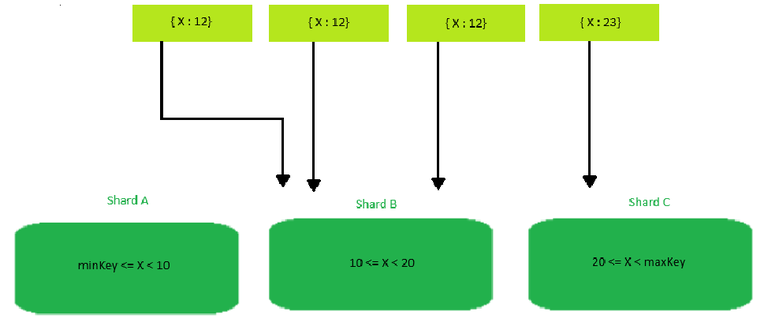Shard Keys in MongoDB
Last Updated :
10 Apr, 2024
Shard keys are a fundamental concept in MongoDB’s sharding architecture, determining how data is distributed across shards in a sharded cluster. Sharding, a key feature in MongoDB, involves distributing data across multiple machines to improve scalability and performance.
In this article, We will learn about Shard Keys, Shard Key Specification, Changing a Document’s Shard Key Value, and Examples of Implementing Shard Keys in MongoDB along with the implementation of Shard Keys.
Shard Keys in MongoDB
- In MongoDB, a shard key is a field or a combination of fields that defines the distribution of data across shards in a sharded cluster.
- Sharding is the method of spreading data across multiple machines to enhance scalability and performance.
- The shard key divides data into small chunks, which are then allocated among the shards based on the values of the shard key.
- The selection of a shard key is important as it directly affects the performance, scalability, and efficiency of the sharded cluster.
Shard Key Specification
- Shard keys are essential in MongoDB’s sharding architecture.
- They specify how data is divided among shards.
- A shard key can be a single field or a set of fields.
- The specification of shard keys is crucial for MongoDB’s scalability design.
- Understanding shard key specifications is important for effective data distribution and access in a sharded cluster.
Changing a Document’s Shard Key Value
In certain situations, we might need to alter the shard key value of a document. This process involves careful consideration and following the MongoDB’s guidelines to ensure data integrity and consistency across the cluster.
Let’s Learn how to change a document’s shard key value easily in stepwise manner.
1. Shard Key Indexes
- Shard keys play a critical role in indexing for MongoDB’s performance optimization.
- Shard key indexes significantly enhance the overall performance of a sharded cluster.
- They enable efficient query routing and execution within the cluster.
2. Choosing a Shard Key
- Selecting a shard key is a crucial decision in MongoDB’s sharding strategy.
- A well-chosen shard key can Reduce hotspots, ensure even data distribution, and enhance query performance.
- The process of selecting an ideal shard key for our application will be explained in detail in our upcoming post.
3. Shard Key Cardinality
- Shard key cardinality is crucial for improving MongoDB’s sharding speed.
- Cardinality refers to the uniqueness of values in a shard key.
- Data distribution and query routing in MongoDB are influenced by shard key cardinality.
- Understanding shard key cardinality is essential for optimizing MongoDB’s scalability.
The picture below illustrates a sharded cluster using the field X as the shard key. If X has low cardinality, the way inserts are distributed might look like this:

Shard Key Cardinality
4. Shard Key Frequency
In a sharded MongoDB context, the frequency of shard key values directly affects query performance and data distribution. Administrators and developers can optimize their sharding tactics by evaluating the frequency of shard keys. We’ll be writing about shard key frequency management strategies soon.
The following image shows a sharded cluster using the field X as the shard key. If a subset of values for X occur with high frequency, the distribution of inserts may look similar to the following:

Shard Key frequency
Examples of Implementing Shard Keys in MongoDB
Let’s consider an example to illustrate the concept of shard keys in MongoDB:
Step 1: Define a Shard Key
Create a collection and specify the shard key index:
db.createCollection("users");
db.users.createIndex({ "username": 1 });
Explanation: In this step, we create a collection named “users” and define a shard key index on the “username” field with ascending order (1). This index will be used to distribute data across shards based on the “username” values.
Step 2: Enable Sharding on the Database
Enable sharding for the database:
sh.enableSharding("testDB");
Explanation: Here, we enable sharding for the “testDB” database, which is a prerequisite for sharding any collection within that database.
Step 3: Shard the Collection
Shard the “users” collection using the “username” field as the shard key:
sh.shardCollection("testDB.users", { "username": 1 });
Explanation: This step shards the “users” collection using the shard key index defined earlier. It ensures that MongoDB distributes the data in the “users” collection across shards based on the “username” values.
Step 4: Insert Data
Insert documents into the “users” collection:
db.users.insert({ username: "user1", email: "user1@example.com" });
db.users.insert({ username: "user2", email: "user2@example.com" });
Explanation: We insert documents into the “users” collection. MongoDB will distribute these documents across shards based on the values of the “username” field.
Step 5: Query Data
Query data from the “users” collection based on the “username” field:
db.users.find({ username: "user1" });
Explanation: Finally, we query data from the “users” collection based on the “username” field. MongoDB routes the query to the correct shard based on the shard key values, ensuring efficient data retrieval.
Conclusion
Overall,In conclusion, shard keys are a foundation of MongoDB’s sharding mechanism, playing a vital role in distributing data and optimizing query performance in distributed environments. Understanding shard key specifications, indexes, cardinality, and frequency is crucial for maximizing MongoDB’s scalability and performance. By selecting the appropriate shard key and following best practices, administrators and developers can design robust sharding strategies that enhance scalability, performance in MongoDB databases.
Share your thoughts in the comments
Please Login to comment...